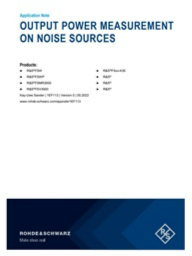Output Power Measurement on Noise Sources
Noise sources used for noise figure and gain measurements are typically controlled by the spectrum analyzer or noise figure meter instruments and are calibrated with their ENR value (Excess noise ratio). While this external control and the use of ENR values is common in noise figure test, it may be difficult in system applications where the noise source control is not available, and the use of ENR values is replaced with the values for the noise output power of the noise source. The calculation of the output power for the noise source requires to know the P_hot value (hot power) which is not a common specification for noise sources used in test and measurement applications.
This application note describes a technique to perform a calibrated noise power measurement (P_hot) with spectrum analyzers and noise sources. The next sections will give further details.
Read More
By submitting this form you agree to Rohde & Schwarz contacting you with marketing-related emails or by telephone. You may unsubscribe at any time. Rohde & Schwarz web sites and communications are subject to their Privacy Notice.
By requesting this resource you agree to our terms of use. All data is protected by our Privacy Notice. If you have any further questions please email dataprotection@techpublishhub.com
Related Categories: Communication, Embedded, Power


